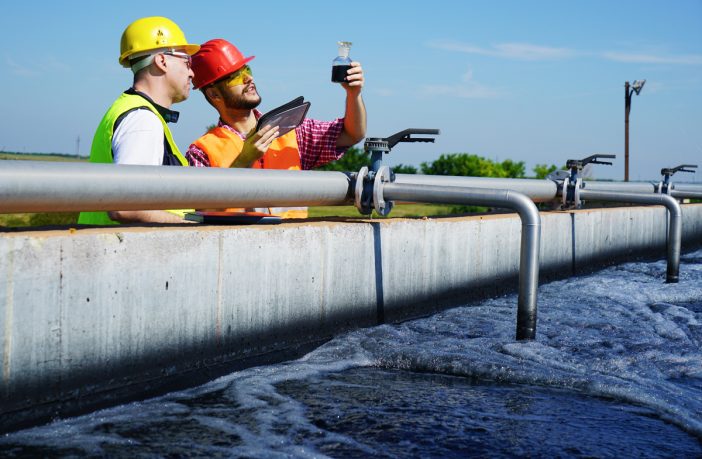Governor Andrew M. Cuomo has announced the completion of the Bay Park Wastewater Treatment Plant’s new $19.6 million Biological Nutrient Removal system — one of the most significant environmental upgrades to the plant since it began operating in 1949. The system is currently operational and removing more than 40 percent total nitrogen from wastewater, meaning an additional 5,000 pounds of nitrogen is no longer being discharged into Reynolds Channel. This will not only improve water quality for fishing, swimming and other recreational activities, but offer greater protection for thousands of homeowners along the South Shore who rely on salt marshes in the Western Bays to act as storm surge barriers and mitigate flooding.
“This new addition to our wastewater infrastructure is another example of New York State not only building back better with solutions that not only protect our health but our precious natural resources and also grow our economy,” Governor Cuomo said. “The upgrade to the Bay Park plant will help prevent nitrogen pollution from degrading marsh islands, killing wildlife and damaging the delicate ecosystem that is vital to Long Island’s resiliency and ecological future.”
While nitrogen and phosphorus are natural parts of aquatic ecosystems, too much of either can pollute the water and result in serious environmental and human health risks, including algae blooms, fish kills and the loss of protective wetlands. Biological Nutrient Removal technology utilizes the latest in denitrification technology and dilution to remove nitrogen and phosphorus from wastewater.
Thanks to $19.6 million in FEMA Public Assistance funding administered by the New York State Division of Homeland Security and Emergency Services, the plant was upgraded to allow the plant to operate in BNR mode or Level 1 BNR to facilitate nitrogen removal. The project included the installation of mixers, flow directing panes and panels (otherwise known as baffling), and a surface waste activated sludge system. This work required civil, structural, mechanical, instrumentation, and architectural services for performing electrical, heating, ventilation, air conditioning, plumbing, demolition and debris removal. As the start-up phase continues through the end of 2020, the plant will continue to optimize the nutrient reduction process. The plant currently treats 50 million gallons per day of wastewater on average from more than half a million Nassau County residents.
United States Senator Chuck Schumer said, “Superstorm Sandy overwhelmed the ancient Bay Park Sewage plant and put tens of thousands of Nassau homeowners, businesses and the whole Back Bay at risk of massive pollution and contamination, and this is why I fought so hard to deliver the record $800 million grant from FEMA to rebuild and modernize it. When the sewage treatment facility failed, it was a wake-up call on the need for immediate federal dollars to reconstruct and modernize the Bay Park Sewage Treatment Plant to prevent future disaster. We secured more than $800 million dollars from FEMA for this effort, and today, we see exactly how those dollars were put to use massively reducing nitrogen pollution in the Back Bays and protecting Nassau homeowners long into the future.”
Nassau County Executive Laura Curran said, “Nassau County is taking immediate steps to help preserve our environment, as well as the health and safety of our waterways and residents. Excessive nitrogen levels have contributed to the collapse and erosion of marshes, which are critically important natural resources that help mitigate storm surge from reaching land. Protecting our environment is the same as protecting our homes.”
New York State Homeland Security and Emergency Services Commissioner Patrick A. Murphy said, “Under the leadership of Governor Cuomo, New York’s emergency preparedness posture has rapidly evolved into one of the nation’s best, and part of this success has been the state’s focus on continuously strengthening our infrastructure and finding ways to mitigate ongoing risks. This new facility is a perfect example of those efforts coming together. Not only will the technologies deployed here help create a cleaner environment, but by helping preserve wetlands, shoreline homes will have an added level of protection against flooding during extreme weather.”
New York State Department of Environmental Conservation Commissioner Basil Seggos said, “Improving Long Island’s water quality has been a hallmark achievement of Governor Cuomo’s tenure, and we are already seeing benefits from this wastewater treatment plant upgrade that will ensure the health of Long Island’s environment and the viability of its economy. I am proud of the work DEC accomplished and applaud its state, county and federal partners who worked together to make this critical project a reality.”
This project also plays a key role in the Western Bays Resiliency Initiative – a group of significant nitrogen reduction projects to improve water quality and storm resiliency by working in concert with one another. These projects include the construction of utilities to facilitate the Sidestream Deammonification Process, scheduled for completion in December of 2021, as well as the major Bay Park Conveyance Project, scheduled to break ground early next year.
The Bay Park Conveyance Project entails routing treated water from the Bay Park Sewage Treatment Plant through an unused 8-mile aqueduct located below Sunrise Highway to the Cedar Creek ocean outfall pipe, which extends approximately three miles from Long Island’s south shore into the Atlantic Ocean. The project is the capstone of the initiative and, when complete, will remove 75 to 90 percent of nitrogen loading from Bay Park Sewage Treatment Plant to Reynolds Channel and the Western Bays.
Executive Director of Citizens Campaign for the Environment Adrienne Esposito said, “Decades of damaging nitrogen pollution from the Bay Park sewage treatment plant has depleted oxygen, diminished fisheries and damaged tidal marshes in Reynolds Channel and the Western Bays. The substantive investments to use state of the art technology to reduce Nitrogen from the Bay Park plant will benefit every south shore resident in Nassau County. We love our bays, and cleaner bays mean happier and healthier communities. We are thrilled with the progress at Bay Park and anxiously await the day when the treated effluent is redirected to the existing ocean outfall pipe at the Cedar Creek sewage treatment plant. CCE applauds Nassau County and Suez for their commitment to upgrading this plant, protecting our marine waters and restoring the Western Bays.”
President of Operation Splash Rob Weltner said, “Being surrounded by water, it’s very comforting to know that our government leaders are working toward making our families’ and our wildlife’s future safe and secure. That’s some good news for all of us.”
Vice President and General Manager of Suez Water Long Island Kevin Chandler said, “We have been entrusted by County Executive Curran to protect and strengthen the county’s environment 24/7 and we take that responsibility quite seriously. This new BNR system, which is currently exceeding performance expectations, is a tremendous first step to reducing the nitrogen load in the Western Bays. Reducing nitrogen will help our fragile ecosystems regenerate and will bring fishing and shell fishing back as well as strengthening marshland which helps protect our shorelines during storms. This technology, and similar innovations, will continue to assist us in following the County’s mandate to operate `cleaner, smarter, better,’ wastewater treatment facilities.”












